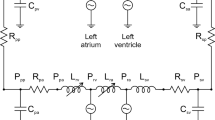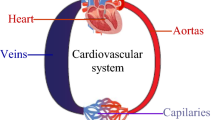Abstract
The cardiovascular system with a lumped parameter model is treated, in which the Starling model is used to simulate left ventricle and the four-element Burattini & Gnudi model is used in the description of arterial system. Moreover, the feedback action of arterial pressure on cardiac cycle is taken into account. The phenomenon of mechanical periodicity (MP) of end diastolic volume (EDV) of left ventricle is successfully simulated by solving a series of one-dimensional discrete nonlinear dynamical equations. The effects of cardiovascular parameters on MP is also discussed.
Similar content being viewed by others
Abbreviations
- X n +1:
-
The EDV of the (n+1)th heartbeat
- X n :
-
The EDV of thenth heartbeat
- Y n :
-
The eject volume of thenth heartbeat
- U n :
-
The mass of the blood through vein to heart
- P s :
-
The systolic pressure of left ventricle
- P d :
-
The diastolic pressure of left ventricle
- P v :
-
The pressure
- P a :
-
The arterial pressure
- P n :
-
The average arterial pressure
- ΔP :
-
The increment of arterial pressure
- F d :
-
Coefficient of diastolic LV
- L d :
-
Coefficient of diastolic LV
- F s :
-
Coefficient of systolic LV
- L s :
-
Coefficient of systolic LV
- V s :
-
The volume of systolic LV
- T :
-
The cardiac cycle
- k :
-
The ratio of ejection time to the whole cardiac cycle
- R a :
-
The resistance of the arterial valve
- R m :
-
The resistance in vein flow
- R :
-
The external resistance
- Q :
-
The volume of blood throughR in a cardiac cycle
- Q 1 :
-
The volume of blood throughL in a cardiac cycle
- C :
-
The compliance
- L :
-
The inertia
- T s :
-
The minimum value of cardiac cycle
- T m :
-
The maximum value of cardiac cycle
- α:
-
The coefficient of feedback
- γ:
-
The coefficient of feedback
References
Goldberger A L. Is the normal heartbeat chaotic or homeostatic? [J].News Physical Sci, 1991,6 (2):87–91.
Gleason W L, Braunwald E. Studies on Slarling's law of the heart-IV relationship between left ventricular end-diastolic volume and stroke volume in man, with observation on the mechanism of pulsus alternans[J].Circulation, 1962,25(5):841–848.
Noble E I, Nutter D O. The demonstration of alternating contractile state in pulsus alternans[J].J Clin Invest, 1970,49(5):1166–1177.
Ritzenberg A L, Adam D R, Cohen R J. Period multiplying: evidence for nonlinear behavior of canine heart[J].Nature Lond, 1984,307(5947):159–161.
Goldberger A L, Bhargara V, West B J. Nonlinear dynamics of the heartbeat-II Subharmonic bifurcates of the cardiac interbeat internal in sinus mode disease[J].Physica, 1985,17D(2):201–214.
Hada Y, Wolfe C, Craige E. Pulsus alternans determined by birentricular simultaneous time intervals[J].Circulation, 1982,65(3):617–626.
Lee Y C, Sutton S J. Pulsus alternans: echocardiographic evidence of reduced venous return and alternating end-diastolic fiber length as causative factors[J].Chest, 1981,80(6):756–759.
Cannon R O, Schenke W H, Bonow R O, et al. Left Ventricular pulsus alternans in patients with hypertrophic cardiomyopathy and severe obstruction to left ventricular outflow[J].Circulation, 1986,73(2):276–285.
Cohn K E, Sandler H, Hancock E N. Mechanism of pulsus alternans[J].Circulation, 1967,36(2):372–380.
Depace N L, Iskandrian A S, Hakki A H. Pulsus alternans after valve replacement for aortic regurgitation[J].Am J Cardial, 1983,52(2):211–213.
Hess O M, Surber E P, Ritter M, et al. Pulsus alternans: its influence on systolic and diastolic function in aortic valve disease[J].J Am Coll Cardiol, 1984,4(1):1–7.
Guntheroth W G. Pulsus alternans[J].Circulation, 1982,66(2):479–480.
Laskey W K, John Sutton M S, Unterker W J, et al. Mechanics of Pulsus alternans in aortic valve stenosis[J].Am J Cardiol, 1983,52(7):809–812.
McGaugher M D, Maughan W L, Sunagawa K, et al. Alternating contractility in Pulsus alternans studied in the isolated canice heart[J].Circulation, 1985,71(2):357–362.
Adler D, Wong A Y K, Klassen G A. Model of calcium movements in the mammalian myocardium, interval-strength relationship[J].J Theor Biol, 1985,113(3):379–394.
Adler D, Wong A Y K, Mahler Y. Model of mechanical alternans in the mammalian myocardium [J].J Theor Biol, 1985,117(4):563–577.
Winfree A T.The Geometry of Biological Time[M]. New York: Springer-Verlag, 1980.
Winfree A T.The Timing of Biological Clock[M]. New York: Freeman, 1987.
Othmer H G.Nonlinear Oscillations in Biology and Chemistry [M]. Berlin: Springer-Verlag, 1986.
Kanters Jorgen K, Hojgaare Michael V, Agner Erik, et al. Short and long term variations in nonlinear dynamics of heart rate variability[J].Cardiovascular Research, 1996,31(2):400–409.
Vila J, Palacios F, Presedo J, et al. Time-frequency analysis of heart-rate variability[J].IEEE Engineering in Medicine and Biology, 1997,16(5):119–126.
Ben-Haim Shlomo A, Frucher Gila, Hayam Gal, et al. Periodicity's of cardiac mechanics[J].Am J Physiol, 1991,261(2):H424-H433.
Frucher Cila, Ben-Ham Shlomo. Stability analysis of one-dimensional systems applied to an isolate beating heart[J].J Theor Biol, 1991,148(2):175–192.
Patterson H. The regulation of the heart beat[J].Am J Physiol, 1914,48(2):465.
FENG Zhong-gang, WU Wang-yi, SUN Dong-ning. Lumped-parameter Model to simulate afterload of systemic circulation[J].Chinese Journal of Biomedical Engineering, 1997,16(3): 212–218. (in Chinese)
Burattini, Gnudi. Computer identification of models for the arterial tree input impedance: comparison between two new simple models and first experimental results[J].Med Biol Eng Comput, 1982,20(2):134–144.
Campell K B, Ringo J A, Neti C, et al. Informational analysis of left ventricle-systemic arterial interaction[J].Ann Biomed Eng, 1984,12(3):209–231.
Stergiopulos Nikos, Westerhoff Berend E, Westerhoof Nico. Total arterial inertance as the fourth element of the Windkessel model[J].Am J Physiol, 1999,276(1):H81-H88.
Kroner P I, Show M J, Other J B. Steady-state properties of barorecepto-heart rate reflex in essential hypertension in man[J].Clin Exp Pharamacol Physiol, 1974,1(1):65–76.
Westerhoof N, Elginga G, Sipkema I. An artificial arterial system for pumping hearts[J].J Appl Physiol, 1971,31(5):776–781.
Author information
Authors and Affiliations
Additional information
Communicated by DAI Shi-qiang
Biography: XU Shi-xiong (1943-), Professor
Rights and permissions
About this article
Cite this article
Shi-xiong, X., Xiao-chun, M. Nonlinear dynamics modeling of mechanical periodicity of end diastolic volume of left ventricle. Appl Math Mech 22, 1183–1191 (2001). https://doi.org/10.1007/BF02436454
Received:
Revised:
Issue Date:
DOI: https://doi.org/10.1007/BF02436454




